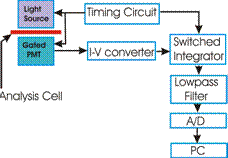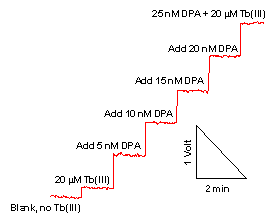Biosensors
Fluorescence Detection of an Anthrax Marker
P. Dasgupta and H. Temkin
Many fluorescent compounds can be excited efficiently with ultraviolet light sources. For instance, AlGaN LEDs operating at a peak wavelength of 291 nm can be used to detect subnanomolar concentrations of dipicolinic acid (DPA, 2, 6-pyridinedicarboxylic acid), a substance uniquely present in bacterial spores such as B. anthracis. This provides a basis for convenient early warning detectors. Our method is based on the terbium-sensitized fluorescence detection of DPA. DPA can be easily extracted from the spores by treatment with low concentrations of surfactants such as deodecylamine. The dipicolinate ion forms chelate complexes with rare earth metals. In particular, the weak native fluorescence of Terbium (Tb) is enhanced by more than x 20,000 upon complexation with DPA.

Gated fluorescence of detection DPA
Furthermore, the already long fluorescence lifetime of Tb is extended to t = 0.6 – 2.0 ms. This permits a time-gated fluorescence detection method, which greatly enhances sensitivity and selectivity over common compounds that exhibit much shorter lifetimes, in the ns range.
The fluorescence intensity, shown below, was linear with DPA concentration in the range of 5- 400 nM with a linear r 2 > 0.9992. The relative standard deviation at the 5 nM level was 2.1% (n=7) resulting in an estimated S/N=3 LOD of 0.4 nM. This performance can be compared with the best thus far reported gated detection LOD of 2 nM DPA obtained with a large bench top gated detection fluorometer with a pulsed Xenon lamp excitation source.
Given that a single spore contains 0.36 fmol DPA, the LOD determined in our experiments with UV LEDs equates to 1100 spores/ml in the collected suspension. Since the illuminated volume is far less than 1 mL, we estimate that a maximum of 0.5 ml or less is needed for detection and the system thus has a detection limit of ~500 spores.
It should be also pointed out that the 290 nm wavelength of the LED used in this experiment it too long to overlap with the DPA absorption peak at 274 nm. Detection limit on the order of 10 spores is thus expected with shorter wavelength LEDs.
Research support: DARPA, NSF, SBCCOM

Response of the detection system to low concentrations of DPA
Nano Tech Center
-
Address
Texas Tech University | Whitacre College of Engineering -
Phone
806.742.3533 -
Email
webmaster.coe@ttu.edu
